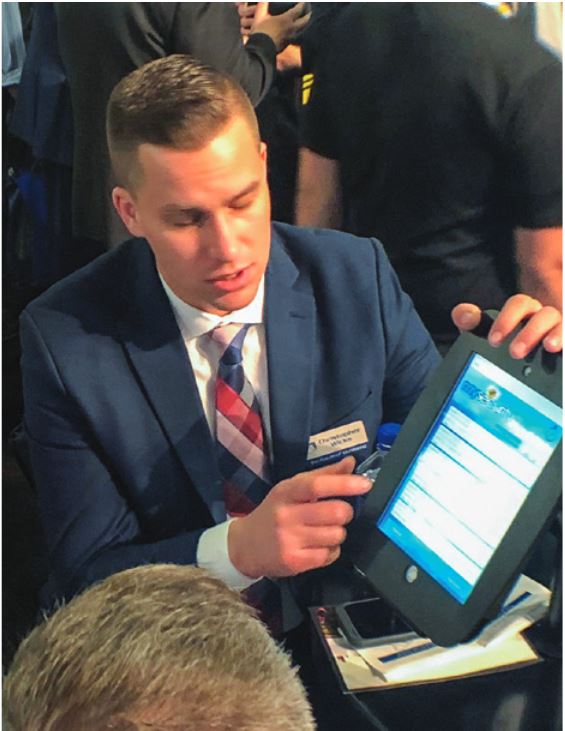Rapid Response Leadership Talks Navigating COVID-19, New Tech Introductions
Rapid Response execs open up about the COVID-19 pandemic, developments within the business and hot monitoring opportunities.

Sometimes a name can just about say it all. Such is the case with Rapid Response Monitoring Services. The wholesale third-party monitored services provider has become synonymous with rapid response to incoming security signals, to meeting dealer requirements and staff needs, to adopting advanced technologies, to managing fast growth and, most recently, to navigating a historic pandemic.
Founded in 1992 by SSI Industry Hall of Famer and current Chairman Russell MacDonnell and President Jeffrey Atkins, Rapid Response today serves an international client base of thousands of security dealers and employs more than 550 trained professionals.
The business has established itself as a leader among central stations by introducing innovative technologies to its dealer base — keeping ahead of the curve with services like PERS, lone worker and app-based offerings, as well as location and operational expansions.
Headquartered in Syracuse, N.Y., where it operates an 80,000-square-foot, state-of-the-art facility, Rapid Response has mirrored redundancy and reliability on both coasts, with a second 35,000-square-foot center in Corona, Calif.
“By offering tomorrow’s generation of monitoring technology today, Rapid is a quantum leap ahead of other security monitoring providers. Every aspect of our technology, infrastructure and operations is multiredundant to work faultlessly and assure error-free, uninterrupted service,” states the firm’s website.
Among Rapid Response’s accomplishments since 2019: released the Radius Portal for device and account management in the IoT sector; launching a false alarm reduction initiative with the release of rapidSMS; and, through May 2020, integration of 66 fully active jurisdictions as part of the ASAP-to-PSAP (Automated Secure Alarm Protocol, public safety answering point) program.
To learn more about Rapid Response’s leading-edge methods and success, SSI spoke with Vice President of Sales and Marketing Spencer Moore, Vice President of Technology and Innovation Morgan Hertel and Vice President of Technical Services Chad Wright.
Let’s jump in and talk about the elephant of 2020: How has the pandemic changed Rapid Response’s business?
Spencer Moore: We’re lucky to have a culture of attention to detail at Rapid Response. We have an army of maintenance and housekeeping staff that clean our facilities 24/7, more than 30 folks who manage that process across our 80,000 square feet in Syracuse. And we’ve done a variety of different things. When we completed our expansion in 2018 we upgraded the HVAC system to include an ultraviolet blue light filtration system, kind of a phase one system that would kill mold and bacterial spores and a few other pathogens.
That positioned us with an infrastructure that when this pandemic took hold we ordered a phase two system. It actually kills viral-type pathogens as well. It’ll kill H1N1, COVID, the flu virus, tuberculosis. There’s a list of 36 pathogens that this high-powered ultraviolet filtration system will kill in our HVAC system.
We also began early on with thermal scanning at our facilities. We have people checked upon entry and we have people checked at lunch. We also provided to all of our team members who were interested in taking home an infrared thermometer so they can do temperature checks prior to commuting into the office. We have been able to move our support departments out of the monitoring centers and position the staff to be able to social distance appropriately in our facility.
We have these pods for staff that create a unique barrier between the different team members that are designed to track down and reflect back toward the person speaking. So that also mitigates any particulates that may come from somebody and possibly cause or spread infection. We have one-way foot traffic patterns so you don’t have people facing each.

Headquartered in Syracuse, N.Y., where it operates an 80,000-square-foot, state-of-the-art facility, Rapid Response has mirrored redundancy and reliability on both coasts, with a second 35,000-square-foot center in Corona, Calif.
We have invested in ultraviolet cleaning technology to sanitize workstations. We have a device called a Glow Tower, which is something you put in a room, lock it up for 30 or 60 minutes and turn this ultraviolet “bomb” off that sanitizes the area. It’s great for conference or training rooms. We’re also using electrostatic sprays on surfaces that remain for about six months, so viruses or bacteria landing on that surface will be eliminated.
Morgan Hertel: We were in great shape on the technology side as we didn’t have to scramble putting together the phone systems or adding bandwidth to be able to have people working from home or have to scramble to put conferencing platforms into play. All that stuff we already had. It’s just a matter of organization and staging and getting everybody ready to go.
Chad Wright: The support of our staff working remote is a change that will probably last long after this pandemic ends. We were traditionally an office where the majority of our staff in our support departments worked onsite and we are now effectively working remote. As Morgan stated, it wasn’t a big shock to our technology systems. We already had all the advanced securities, protocols in place to allow anyone to work from their home just as if they were in the four walls of a Rapid facility.
One of the lasting changes from this, at least from my perspective, will be the type of technical support we can give our customers. So when they are impacted from a staffing perspective, we can step in and do more things. To give you an example of that, our technical support team has taken on a lot of third-party service activation and changes that normally our dealers would logon and do. Because they have been impacted with staffing levels and the ability to get folks out of the office onsite to do work, we’ve taken on more of that responsibility. This allows them to continue providing the utmost customer care to all of our ultimate end customers.
What are some of the hardships you have heard from the dealer base? Do you see some opportunities coming out of it as well?
Hertel: One of the things coming out of this is people’s ability and willingness to make changes. Customers are telling us, “My world has changed a lot in a way that I interact with a lot of different things. I am now willing and wanting to also make some of those changes.” We’re getting dealers who engage with us on a whole different level on some of the programs, the services that we’ve had for a while. Whereas in the past they might have put these things on the back burner, they’ve become much more accepting of changes today. From that perspective, this has been an interesting time. We’ve been able to roll out several new programs that customers actually really ended up liking a lot.
Can you give some specific examples?
Hertel: We’ve had a program for a while that’s been used for sending out notifications via SMS. A year-and-a-half ago, trying to get a dealer to get onboard with being able to communicate quickly, usually by SMS, was a challenge. Traditional dealers were not that very technical, they didn’t really understand it from a social perspective. They thought it was just an impersonal way of doing things. Today, fast forward a year or so and all of a sudden it’s like, “This is great because we can do this quickly and easily and efficiently and contactless.” To use the buzzword that’s going around.
That’s just one example of a lot of different things that people really look at to make their lives easier. Maybe it’s just timing, maybe it’s just knowledge. Dealers’ time is now split up differently. They’re no longer driving around seeing everybody. They’re like all of us who are stuck in a place and so they have a lot more time to really work on things that they couldn’t work on before. They have more time to focus on their customers. There are dealers looking to have more consistent engagement with their customers, and so we’ve been able to get some of those initiatives going.

Whether in person or lately virtually, Rapid Response enjoys stepping dealers through its three differentiators of people, training and technology, which is being demonstrated above at an exhibit booth.
Do you see any specific types of technology or services that may spawn out of this from the monitoring side of the equation?
Moore: There have been a lot of calls going out to installation companies from a variety of different sources regarding those types of equipment. Thermal imaging is something the dealer base is seeing. It has not really made it to the monitoring centers yet as something to monitor, but if it becomes more of a normal way of life, I could definitely see that. I have seen some offerings that could be monitor-type products where they’re doing contact tracing through Bluetooth. It would allow an employer to notify everybody who’s been in contact with an infected individual. Those are usually tied into some other monitorable-type solution, like a mobile app, to increase the value proposition.
Wright: We have been hearing the question raised about getting into IT security monitoring. Especially as the workforce shifts home, we’re monitoring property through modern alarm systems, video and everything else, why not extend into IT security monitoring now that that paradigm has shifted? I think there’s a great opportunity for people to say, “I use a lot of tools, techniques and software responding to events on the alarm, fire, carbon monoxide and water sides; I can do the same thing for companies from an IT security perspective.”
Do you think it will also hasten opportunities for home health monitoring?
Moore: It has definitely increased the future opportunity. There was a trend prior to this, to look at more and more at telemedicine. We have seen some increased activity in potential partners looking to explore working more with centers like us for remote patient monitoring.
Hertel: It’s a little early to tell what other services and things like that are cropping up from this. We’re a ways out seeing some of that stuff start to formulate. There’s certainly a whole concept about working remotely, doing things differently that has gotten a lot of wheels turning out there.
If you enjoyed this article and want to receive more valuable industry content like this, click here to sign up for our FREE digital newsletters!

Security Is Our Business, Too
For professionals who recommend, buy and install all types of electronic security equipment, a free subscription to Commercial Integrator + Security Sales & Integration is like having a consultant on call. You’ll find an ideal balance of technology and business coverage, with installation tips and techniques for products and updates on how to add to your bottom line.
A FREE subscription to the top resource for security and integration industry will prove to be invaluable.














